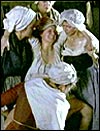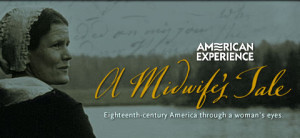A Midwife’s Tale: The Life of Martha Ballard, Based on Her Diary, 1785-1812
By Patty Williams (mother) –
“A Midwife’s Tale” does not read like a novel. It is a factual account of the life of Martha Ballard, based on her diary. I was not immediately drawn into this book, but it won the Pulitzer Prize, so it must be a worthwhile read—right? Therefore, I persevered, and am happy to say that I was rewarded in doing so.
Martha lived with her family in Hallowell, Maine, along the Kennebec River. I was surprised to learn that by the time she started writing the diary, she was already 50 years old. The year was 1785, and she continued writing for the next 27 years. During that time she attended 816 births, cared for the sick, and swaddled the dead as well as the newborn.
Travel was difficult, and getting where she needed to be was a challenge in itself. She wrote of walking through waist deep snow, high winds, and being barely thawed from one journey before taking another. She traveled the river by water, by ice, and by faith. One entry told of crossing the river and being so tired that she had to be pulled up the river bank on the other side. She once described breaking through the ice to her waist and continuing on to the delivery, dripping. Why was she willing to do this? Martha believed that God protected her in her difficult travels, and sustained her through difficult deliveries. This gave her the strength to continue her work. It was her “inner calling.”
Martha, though not a doctor, was one of the busiest medical providers in Hallowell. She was a “social healer.” Rather than professional training, social healers had years of “hands on ” experience. Her main concern was making the patient feel better, and she went further, stayed longer and did more to accomplish that than most of the doctors of her time. In fact, she was a threat to the local doctors. Even the elite families of Hallowell would employ her to deliver their babies as she had a much higher success rate. She described an incident when Dr. Page was called to a difficult delivery, and the baby was stillborn with dislocated limbs. Martha attributed this with his lack of familiarity in the “difficult manipulation required in breech births.” She gave God the credit for her success, but she knew that He had worked his will through her hands.
Hallowell had its share of religious disagreements, scandals, & unwed mothers. Often when Martha delivered a baby, the unwed mother would tell her the name of the father. I found it humorous that the “Midwifes Guide” stated—“a good midwife ought to be faithful and silent.” Therefore, when she delivered a baby to an unwed mother, her diary named the mother only. Everything belonged to the men, even the babies.
It was obvious to me that she was a woman who liked neatness, order and harmony. Arriving home after being up all night delivering a baby, she would often find her house a mess, and instead of getting much needed rest, would stay up doing house work. I could totally identify with this. How can you rest when things are a mess! More exhausting than her work was the discord in her family. While her husband was in debtor’s prison, son Jonathan moved his family into her house, and she was given a room. She became a border in her own home. She described the effect of family tumult as bringing on “a fatigue so draining, that I could hardly lift my head from the pillow.”
find her house a mess, and instead of getting much needed rest, would stay up doing house work. I could totally identify with this. How can you rest when things are a mess! More exhausting than her work was the discord in her family. While her husband was in debtor’s prison, son Jonathan moved his family into her house, and she was given a room. She became a border in her own home. She described the effect of family tumult as bringing on “a fatigue so draining, that I could hardly lift my head from the pillow.”
I felt that writing her diary was very important for her mental health, especially in her later years. In its pages she could list her accomplishments. This part of her life she could control. If, like me, you find this book a challenge, don’t give up. Whimsical easy reads are too soon forgotten. The rich content of this book will be long remembered.
By Tamera LeBeau (daughter) –
The introduction to A Midwife’s Tale cites reviews of Martha Ballard’s diary by earlier historians, one of whom called it “trivial and unimportant” and another who stated “like many diaries of farm women, it is filled with trivia about domestic chores and pastimes.” If this diary was such a mundane and unimportant work, how did Laurel Thatcher Ulrich turn it into a Pulitzer-Prize winning book? I would postulate that this has to do with the perspective of the historian/reader and how he or she perceives the importance of the contributions of women to the greater society. It’s true that Martha spent a great deal of time tending her garden, baking bread, spinning cloth, and tending to seemingly endless household chores. However, her diary does not show her only in this light; she was also a strong woman who held a valued and respected profession in her community. Writing a Pulitzer-Prize winning book based on this source material…what else would one expect from the woman who coined the phrase “well-behaved women seldom make history”?
It was during Martha’s middle-age years when she had the opportunity to grow into her career as a midwife. At this point, her children were mostly grown and she had daughters who were old enough to tend to the majority of the household duties but had not yet married and established their own households. As a result, she was free to take calls for a variety of healthcare needs; she assisted in many births, but also with numerous illnesses and injuries using local plants, purchased medicines, miscellaneous household ingredients (beeswax, cornmeal, and vinegar, to name a few), and even brandy and rum. Unlike the doctors of the day, midwives did not bleed their patients and they often stayed with them longer than the usual doctor visit, offering compassion and support to both the ailing person and his or her family. Martha traveled through ice and snow to tend to her patients, spending many nights away from home only to return after a sleepless night and begin tending to her own family. Her devotion to her community, her calling as a midwife, and her faith in her God kept her going.
During this period in history, the midwife was the most frequently consulted medical professional as doctors often practiced part-time while pursuing other careers. This kept the practicing midwives very busy. However, the prominence of and respect for midwives in the medical profession was starting to change. As stated in the book, “In 1820, a professor at the Harvard Medical School published an anonymous treatise in which he argued that women should no longer be employed as midwives because their character would be destroyed by acquaintance with the dissections essential to thorough instruction in medicine.” Ulrich calls this a “classic double bind” stating, “Women could not qualify themselves to practice midwifery without mastering general medicine, but learning general medicine would disqualify them as women and therefore as midwives.” How distressing this must have been to the midwives of the day, having to choose between being seen as less of a woman or less of a healer.
As Martha’s daughters grew older, married, and established their own families her midwife practice changed. Although Martha and her husband employed several young maids over the course of the years, these helpers did not tend to be as reliable as Martha’s own daughters had been. As a result, Martha found  herself being drawn back into many of the household duties while her own energy level and health decreased with age. The number of house calls Martha was able to take decreased accordingly. During this time, Martha’s husband was sent to debtors’ prison, leaving her as the head of the household. As one might imagine, this situation was not tolerated for long. Martha’s son soon moved his family into the house, taking control of the household. One might think that Martha would have found it a welcome occurrence to have more helping hands around; however, Martha chafed at the situation. She had gone from being a respected member of the community, taking care of her family and her patients, to basically being a boarder in her own home. I can imagine that this lack of control over her own life did not sit well with such a strong and capable woman.
herself being drawn back into many of the household duties while her own energy level and health decreased with age. The number of house calls Martha was able to take decreased accordingly. During this time, Martha’s husband was sent to debtors’ prison, leaving her as the head of the household. As one might imagine, this situation was not tolerated for long. Martha’s son soon moved his family into the house, taking control of the household. One might think that Martha would have found it a welcome occurrence to have more helping hands around; however, Martha chafed at the situation. She had gone from being a respected member of the community, taking care of her family and her patients, to basically being a boarder in her own home. I can imagine that this lack of control over her own life did not sit well with such a strong and capable woman.
Some nonfiction books are written to read like fiction, in a very approachable manner that quickly engages the reader. It’s true that A Midwife’s Tale is not one of those books. Excerpts from a 200-year-old diary alongside historical commentary do not necessarily make for a quick and easy read. However, this book is rich with ideas and insights into a time long past, but that still has relevance today. Along with the tale of a midwife, readers will learn more about the family life, social structures, economics, politics, and even the religious turmoil of the time. I would highly recommend the book for those who are interested in learning more about the life of a strong woman and the challenging time in which she lived.







Patty, “Whimsical easy reads are too soon forgotten.” AMEN.
I love your review. I find it such a facinating look back in history. I also found the doctors interaction with midwives so interesting.
I also think the resurgence of midwives is also interesting. And midwives are in my opinion the key to healthy deliveries in the developing world.
Beautiful! I been fascinated with midwifery and these amazing women for a long time! Looks like i need to pick up the book. I am amazed by these early midwives. Definitely the others of our pasr and current feminist movements. They were looked down upon by the “intelligent” people of the day but were the people that everyone actually wanted to take care of them.
I can’t even imagine trudging through ice, water, and horrible weather. That is passion. We could all learn to be so dedicated!
Thank you for the wonderful book reviews. And it is true, sometimes the slowest books are the best!
Thanks Patty (mom) and Tammy for your reviews of this book. Its interesting and sad to see that such a capable midwife was looked down upon by the medical community because she hadn’t been properly trained in their eyes. On another note, I see that her dedication and success came from feeling that she was “called” to be a midwife, and that owed her successes to God. The older I get the more I realize that one’s motivation has much to do with one’s ultimate success or failure in whatever you persue.
That’s so true, Jenny!
Thanks Patty and Tamera, I really enjoyed this review. I have great-great something grandmothers that were midwives, so that lends an extra interst to this topic for me. I also enjoy history.
Patty, I particularly enjoyed your last paragraph. Well said!
I was going to comment about my love for the book but reading your reviews the thing that impresses me the most is the idea of getting to read this with your mom. Election years are increasingly rough with my mother and I but we do share a love of family history and literature. I think I’m going to suggest that we read/reread A Midwife’s Tale together- that could be a much needed balm for our recent contention. Thanks, ladies for the great idea!
Excellent review. Thanks for posting. . . you’ve inspired me to pull the book out again and finish it!
Although I haven’t read this book, Laurel Thatcher Ulrich spoke about this book at Weber State University about 20 years ago while I was a student there.
It was very interesting to hear about her process as she mapped out the people and timelines documented in the journal. By doing this, she was able to make connections between the events that had been offhandedly dismissed by prior scholars.
When I heard her speak, she said that she had originally been asked to speak at BYU, but as the time approached, she was told that she could only speak to the faculty. As a result, she canceled that engagement and spoke at WSU.
At the end of her presentation during a question and answer session, someone asked her why she wasn’t allowed to speak to the student body at BYU. She said she really didn’t know. She called her Stake President to see if there was a problem that she should be aware of, and he didn’t know of anything either.
Needless to say, we at Weber State were the fortunate beneficiaries of the other school’s rather confusing restriction.
I’ll have to put that book on my reading list. Thanks for the reviews.
Thanks for your comment! It would have been so interesting to hear Ulrich speak about her process for writing the book. While I was reading it, I often wondered how she could keep straight all of her historical research and make the connections to the people and situations that were sometimes just mentioned in passing in the journal. I’m sure it was a long and involved process. That’s strange about BYU’s decision to not allow Ulrich to speak to the students. From the timeframe you mention, it sounds like that wasn’t long after I graduated from BYU. From my experience of being a student there, I can tell you that they tended to shy away from anything that they thought might maybe, even possibly, be slightly controversial. But shouldn’t things that make you think about the world in a different way be part of higher education??? Ok, that’s a topic for another post. 🙂 Back to the book… Yes, definitely put it on your reading list!
I agree. Thinking about the world in a different way would be much more beneficial than an education with blinders on.